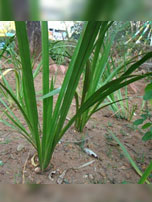SHAHEED
KARTAR
SINGH
SARABHA
A Y U R V E D I C M E D I C A L C O L L E G E & H O S P I T A L
Affiliated to Guru Ravidas Ayurved University, Hoshiarpur Punjab
Affiliated to Guru Ravidas Ayurved University, Hoshiarpur Punjab

Botanical Name: Acorus calamus Linn.
Family : Araceae
Introduction:
Vacha improves the intelligence and speech of an individual. So it given to the babies. (Rajonyadi churna indicates that ‘sarwa rogeshu baleshu’).
Scientific classification: Blue flags belong to the family Iridaceae and are classified in the genus Iris. The sweet flag belongs to the family Araceae and is classified as Acorus calamus. The cattail flag belongs to the family Typhaceae and is classified as Typha latifolia.
Names in different Indian languages:
English : Sweet Flag, Calamus.
Hindi : Bacc, gorbacc
Kannada : Baji
Malayalam : Vayambu
Sanskrit : Vaca, ugragandha
Tamil : Vasampu
Telugu : vasa
Unani : Waj-e-Turki, Waj
Synonyms:
Ugraa, Golomi, Shadgranthaa,
Shataparvaa, Tikshnagandhaa,
Kshudra-patra, Maangalyaa, Ghorbach
Varieties and Adulterants:
1. Vacha — A. calamus Linn.
2. Pãraika vachã (Haimavati) I. germanica Linn.
3. Kulanjana (Mahabhari vacá) — Alpinia galanga WiNd.
4. Sthulagranthi (Mahãbhäri) — Zingiber zerumbet Rosc. ex. Smith
5. Dvipãntara vachã — Smilax china Linn..
6. Paris polyphylla
7. Inula racemosa [AD]
8. Iris germanica [AD]
9. I. versiolor
10. I. nepalensis
11. I. ensata
12. I. kumaonensis
Morphology:
An aromatic marsh herb, with creeping root-stock.
Leaves— distichous, base equitant. Peduncle leaf-like.
Flowers— green, densely crowded on a cylindric, sessile ,spadix. Sepals, 6;arbicuiar.
Fruits—few seeded berries.
Seeds— oblong
Distribution and Habitat:
Cultivated in wet places in India
Chemical Constituents:
Alpha-asarone , acorine, eugenol, asarone, caffeine and little astringent matter. Acolamane, acorenone, acoramone, acorone, cis-& trans-asarone, beta asarone azulene, cadalene, calacone, calacorene, calamene, calamenol, calamone, calamenone, calamenene, calarene, beta- gurjunene, camphene, eugenol, relekin, preisocalamendiol, acoric acid, calamen diol, calamenone
Properties:
Rasa Katu, Tikta
Guna Laghu, Tiksna
Virya Usna
Vipãka Katu
Karma Kapha-vatahara, Lekhaniya, Medhya
Karma : Kapha-vatahara, Lekhaniya, Medhya
Indications:
Unmãda, Apasmra, Jvara.
Part Used :
Rhizome
Dosage :
Powder 2-4 g
External Uses :
Being analgesic and anti-inflammatory. its paste is useful in rheumatoid arthritis. osteoarthritis and hemiplegia. Its juice is used as ear drops for earache and tinnitus. The smoke is effective in painful piles. Pradhaman nasya of vacha is useful in heaviness of head, headache. Lassitude, lethargy and excessive sleep. Vacha is also effective as an antiseptic on wounds. It is widely used as an antiseptic in animals for application on wounds.
Internal Uses :
Nervous system : It is very useful in diseases of the nervous system and hence it is a well known medicine for brain since ages. It is highly effective in mania, epilepsy and other brain disorders. Vacha alleviates the excessive kapha accumulated in the manovaha srotas which causes various psychological disorders. It is helpful in clearing the passage of air in rhinitis. It reduces convulsions and pain It’s useful in spasmodic contraction of body and paralysis, It reduces bodily kapha and mental dosha and restores consciousness, It is the best medicine for children having lower intellectual level, Vacha powder in small doses with honey is given daily to such children so that their body strength as well as intellectual level improves.
Digestive system : It acts as an appetizer and anti despotic due to its katu and ushna veerya. Vacha reduces abdominal colic by acting on worms caused by kapha. It is the most suitable drug for inducing emesis for removal of kapha. Vacha can be used in both, vaman and asthapan. Its emetic property is very useful in indigestion, anorexia, constipation, piles and flatulence, It is a digestive and dears the mouth.
Circulatory system Vacha is used in heart diseases as it controls the heart rate.
Respiratory system : Since it is useful in alleviating kapha and vata of the respiratory tract, it is used extensively in cough, asthma, pharyngitis and laryngitis. In these diseases, keeping a piece of vacha in the mouth as a lozenge gives quick relief. When emesis is required in asthma caused by obstruction of kapha, 4 to 8 g. of fresh vacha powder + ‘10 g, of rock salt is given along with warm water. The patient is asked to drink 1oz. of warm water over it. This causes removal of kapha through emesis and the dyspnoea is reduced.
Urinary system : Vacha is useful in dysuria caused by kapha: It is also useful as a lithottypsic.
Reproductive system : If is an oxytocic. A mixture of saffron, long pepper and vacha is used In painful labour, Vacha is also used in dysmenorrhoea. The most important action of vacha is to clear the obstruction caused by kapha. Vacha + saffron + long pepper should be used as a galactagogue in post partum conditions.
Skin Since vacha is a diaphoretic, medogami and tvachagami, it is used internally as well as externally in many skin diseases. A formulation called vachadi siddha taila is very useful in chronic skin diseases due to its stimulant action on the skin.
Satmikaran Since it has a curetting action, it reduces obesity by alleviating kapha dosha and meda dhatu. Regular use of vacha in small does acts as a rasayan on kapha and meda. It has been successfully, used since ages on disorders of speech.
Temperature : Since it is a diaphoretic. it is useful in fever caused by obstruction of sweat. It is also useful in alleviating symptoms like drowsiness and delirium associated with high fever, Vacha alone is an extremely useful medicine for teething problems in children.
Important Yogas or Formulations:
Saraswat churna, Medhya rasayan., rajanyadi churna
Vacãdi curna, Vacãdi ghrta, Bãla cãturbhadra cürna, Vacãvaleha